| front |1 |2 |3 |4 |5 |6 |7 |8 |9 |10 |11 |12 |13 |14 |15 |16 |17 |18 |19 |20 |21 |22 |23 |24 |25 |26 |27 |28 |29 |30 |31 |32 |33 |34 |review |
 |
Outbreaks are a much larger
menace today than they were just three decades ago. They are larger in
two ways.
First, changes in the way
humanity inhabits the planet have led to the emergence of new diseases
in unprecedented numbers. In the thirty years from 1973 to 2003, when
SARS appeared, 39 pathogenic agents capable of causing human disease
were newly identified.
The names of some are
notoriously well-known: Ebola, HIV/AIDS, and the organisms responsible
for toxic shock syndrome and legionnaire’s disease. Others include new
forms of epidemic cholera and meningitis, Hanta virus, Hendra virus,
Nipah virus, and H5N1 avian influenza.
This is an ominous trend. It is
historically unprecedented, and it is certain to continue.
Second, the unique conditions
of the 21st century have amplified the invasive and disruptive power of
outbreaks. We are highly mobile. Airlines now carry almost 2 billion
passengers a year. SARS taught us how quickly a new disease can spread
along the routes of international air travel. Financial markets are
closely intertwined. Businesses use global sourcing and just-in-time
production. These trends mean that the disruption caused by an outbreak
in one part of the world can quickly ricochet throughout the global
financial and business systems. Finally, our electronic
interconnectedness spreads panic just as far and just as fast.
This has made all nations
vulnerable – not just to invasion of their territories by pathogens, but
also to the economic and social shocks of outbreaks elsewhere. Some
experts have gone so far as to state that there is no such thing as a
“localized” outbreak anymore. If the disease is lethal, frightening, or
spreading in an explosive way, there will always be international
repercussions.
The best defence against
emerging and epidemic-prone diseases is not passive barriers at borders,
airports and seaports. It is proactive risk management that seeks to
detect an outbreak early and stop it at source – before it has a chance
to become an international threat. We as a public health experts are now
in a good position to act in this pre-emptive way.
The opportunities are multiple.
The pressures of population growth push people into previously
uninhabited areas, disrupting the delicate equilibrium between microbes
and their natural reservoirs. This creates opportunities for new
diseases to emerge.
Population growth also puts
people in close proximity to domestic animals, creating evolutionary
pressures and opportunities for pathogens to jump the species barrier.
Of the emerging pathogens capable of infecting humans, around 75%
originated as diseases of animals.
Environmental degradation and
changing weather patterns allow known diseases to flare up in unexpected
places, at unexpected times, and with unprecedented numbers of cases.
Intensive food production,
including the use of antibiotics in animals, creates additional
pressures on the microbial world, leading to mutations and adaptations,
including drug resistance.
And we must not forget:
drug-resistant strains of viruses and bacteria also travel well
internationally.
International health security
focuses attention on these complex and interrelated threats to our
collective security.
They reinforce our need for
shared responsibility and collective action in the face of universal
vulnerability, in sectors well beyond health.
|